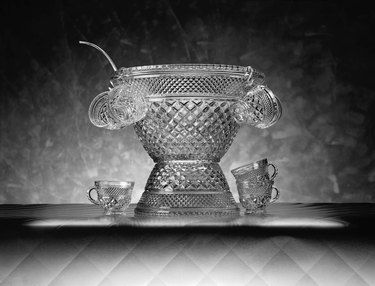
Most people who were alive in the 1970s probably remember when lead-based paints were banned for residential use. It happened in 1978, and the publicity campaign was significant. Homes built before then probably have at least some lead-based paint, and when that cracks or peels, it creates dust and chips. The public was shocked to learn that children could be exposed to lead when they chewed on surfaces containing lead-based paint, like door edges and windowsills.
With this in mind, one would naturally wonder what other things might contain toxic lead, including drinking glasses. Lead can cause severe health damage, and it's especially dangerous for children. Experts advise that you don't drink from lead crystal glasses or anything containing lead.
Video of the Day
Video of the Day
What Contains Lead?
Besides doors and windowsills, older homes can have lead paint on stair rails, porches, home exteriors and other painted surfaces. The chips and dust can get into the soil, but lead also occurs naturally in high concentrations in certain places. It can contaminate yards and playgrounds, so the next time you see a child eating paint or dirt, stop him from doing so. Older playground equipment might also contain lead-based paint; playground surfaces made of shredded rubber could also have it.
People who come in contact with lead through work or hobbies can also be at risk and can put others in danger. Fishing sinkers, bullets, some stained glass pieces and leaded pottery glazes and clays can all pose hazards if they are not handled properly. Use the right equipment and keep the area ventilated when working. Never touch your mouth or handle food when working with lead materials and remember to wash your hands.
There are bans in place for public safety, but older products can be problematic. Things like antique furniture, toys and jewelry can also have lead and lead-based paints. As recently as 2004, the Consumer Product Safety Commission recalled 150 million pieces of toy jewelry made from metal that were sold in vending machines. Drinking water can have lead in it too, and what about lead crystal drinking glasses?
What Is Lead Crystal?
Lead crystal drinkware was popular for a long time, and you or someone you know might own some of these glasses, goblets and decanters. They usually have detailed designs cut into the glass that add three-dimensional texture. The crystal catches the light at different angles and looks substantial and sophisticated, making it perfect for formal events.
This kind of glass contains a lead oxide, which increases the refractive index. It reflects more light than regular glass, and oddly enough, it is not a crystal at all; it's just fancy, heavy glass. If you're not sure if something is made out of lead crystal, you can test it to see. First, tap on it with a metal utensil and listen for a drawn-out, chiming kind of sound.
You can also compare its weight to a similar glass item of the same size. A lead crystal glass is heavier. If you notice cuts in the piece, know that while glass cuts are sharp, lead crystal ones have more rounded edges. You should also see a rainbow prism on the glass when you shine light onto it.
Should I Throw Out Lead Crystal?
There are no studies showing that lead is safe for consumption, so why take a chance? Experts advise against drinking from lead crystal drinkware. Touching the surface isn't seen as harmful, but consuming anything inside of them might be. There is the risk of lead leaching into the beverage, which is something you should consider.
Lead is particularly dangerous for young children since it can cause severe and permanent brain damage. Studies have shown that even low levels of lead in children can negatively impact academic achievement and the ability to focus. On top of those adverse side effects, scientists have also linked lead to nervous system problems and blood disorders. With all of this information out there about how bad lead can be for humans, it makes sense that there are pretty much no companies left that use lead in paint, drinkware or other products.